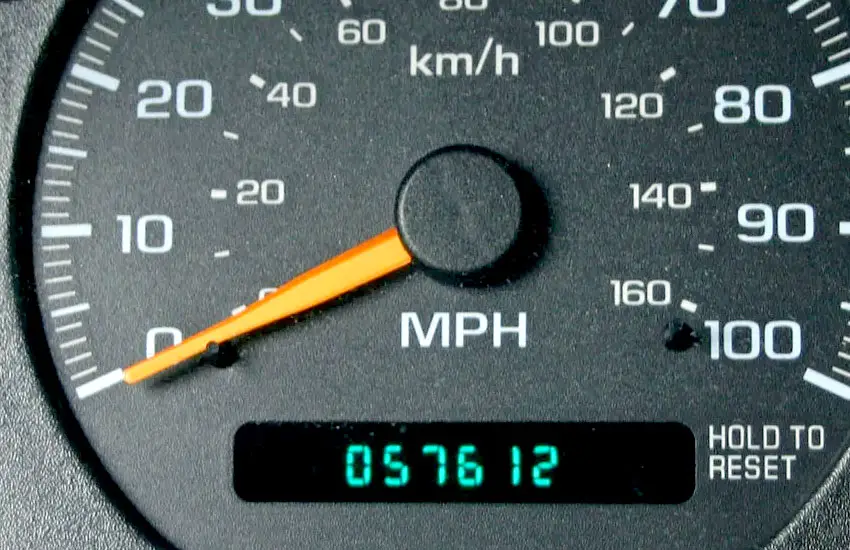As an Amazon Associate, I earn from qualifying purchases at no extra cost to you.
Digital Odometer Display Not Working: Causes and Fixes!
Have you ever been driving, only to glance at your car's dashboard and notice that the digital odometer display isn't working? It's a frustrating experience that can leave you wondering if your vehicle is experiencing a serious issue or if it's something simple to fix. Whether you’re dealing with a car that’s older or a newer model, a malfunctioning odometer display can make it difficult to track your mileage, affecting everything from routine maintenance schedules to resale value.
In this post, we'll take a deep dive into the common reasons why digital odometer displays stop working, how you can troubleshoot the problem, and what steps you can take to fix it. So, if you're facing this issue, keep reading for helpful insights and solutions.

Why Is Your Digital Odometer Display Not Working?
There are several reasons why a digital odometer might stop displaying your mileage. To get to the root of the issue, it's important to first understand the parts of the car that influence the odometer and how they work together.
The digital odometer is part of your vehicle’s instrument cluster, which houses various other displays such as the speedometer, fuel gauge, and tachometer. The cluster is responsible for gathering data from your car's sensors and displaying it on the screen. The odometer itself counts how many miles your car has driven and stores that data electronically, making it easier to read and more accurate than older mechanical odometers.
If your digital odometer stops working, the problem could lie within the instrument cluster itself, the wiring, or even a malfunctioning sensor. Here are some of the most common reasons why the digital odometer may stop displaying properly:
1. Electrical Problems
The most common culprit behind a malfunctioning digital odometer is an electrical issue. The odometer relies on a steady flow of electricity to work, and any interruption in that flow could cause it to stop functioning. Electrical problems can stem from a variety of sources, such as:
- Fuses: If the fuse that controls the instrument cluster has blown, the odometer will stop working. A blown fuse is a quick and easy fix, so it's always worth checking the fuses if you notice your digital odometer isn't functioning properly.
- Wiring issues: Loose, frayed, or damaged wires can interrupt the signal sent to the odometer. In such cases, the odometer may show erratic readings or fail to work entirely.
- Battery issues: Sometimes, a weak or dying battery can cause intermittent electrical problems in your vehicle's system, including the instrument cluster and the digital odometer display. Make sure your car’s battery is in good condition before troubleshooting further.
2. Faulty Instrument Cluster
The instrument cluster, which houses the digital odometer, is a complicated system with many internal parts that work together to display information. If one of these internal components is malfunctioning, it could cause the odometer display to stop working. Some common issues include:
- Burnt-out LED or LCD display: Over time, the LEDs or LCDs that light up the digital display may burn out, leaving your odometer screen blank or displaying incorrect information. This is especially common in older vehicles where the instrument cluster may have been subjected to wear and tear.
- Damaged circuit board: The circuit board inside the instrument cluster is responsible for processing the data from the car's sensors. If this board is damaged or malfunctioning, the digital odometer will not display any readings.
- Software malfunctions: Some vehicles rely on software to run the instrument cluster and communicate with other car systems. If the software becomes corrupted or encounters a bug, it can cause the digital odometer to malfunction.
3. Sensor Problems
The digital odometer relies on various sensors in the vehicle to determine the mileage. These sensors track wheel rotation, engine performance, and other factors to calculate the car's distance traveled. If any of these sensors are malfunctioning, it can lead to incorrect mileage readings or even a completely blank odometer.
Some of the most important sensors that impact the odometer include:
- Vehicle speed sensor: This sensor measures the speed at which your car is moving and plays a crucial role in calculating the total distance driven. If it fails, the odometer may freeze or display inaccurate readings.
- Transmission sensor: The transmission sensor helps the vehicle monitor its gear position and the rotation of the wheels. If this sensor is faulty, it can prevent the odometer from calculating the miles accurately.
4. Physical Damage
Accidents or physical damage to your vehicle can also cause the digital odometer display to malfunction. For instance, if the instrument cluster is involved in a collision or if the dashboard is removed or tampered with, it can disrupt the wiring and connections to the odometer, rendering it inoperable. In such cases, replacing or repairing the instrument cluster may be necessary.
5. Software or Calibration Errors
In some cases, a simple software glitch or a calibration error may be the cause of the problem. Most modern cars rely on complex software to process data from various sensors, and sometimes these systems can get out of sync. A calibration reset can often solve the issue, allowing the odometer to function properly again.
How to Fix a Digital Odometer Display That's Not Working
Now that we've covered the common causes of a malfunctioning digital odometer, it's time to look at some possible solutions. Here's how you can fix the issue, step by step:
1. Check the Fuses
The first thing you should do when your digital odometer stops working is check the fuses. A blown fuse is one of the easiest and most common causes of an inoperable instrument cluster, and it's something you can fix yourself. To check the fuses:
- Locate your car's fuse box. In most vehicles, the fuse box is located under the dashboard on the driver's side or in the engine bay.
- Find the fuse diagram. This diagram should tell you which fuse corresponds to the instrument cluster or the digital odometer.
- Inspect the fuse. If it appears broken or burnt out, replace it with a new one of the same rating. If the fuse is intact but the problem persists, you may need to move on to other troubleshooting methods.
2. Inspect the Wiring
If the fuses are fine, the next step is to inspect the wiring. Damaged or loose wires can easily interrupt the connection between your car's sensors and the digital odometer. If you're comfortable with DIY repairs, you can check the wiring by:
- Removing the dashboard panel to access the instrument cluster.
- Visually inspecting the wiring for signs of damage, such as fraying, corrosion, or loose connections.
- Tightening any loose connections or repairing damaged wires. If you don't have experience with car wiring, it's best to leave this step to a professional mechanic.
3. Replace the Instrument Cluster
If there is damage to the instrument cluster itself, such as a burnt-out LED or a faulty circuit board, you may need to replace the entire unit. Replacing the instrument cluster is a more involved repair and may require the assistance of a professional mechanic or an auto electrician. However, it is possible to replace the unit yourself if you have the right tools and experience.
4. Calibrate the Odometer
If you suspect the issue is software-related, you can try resetting or calibrating the digital odometer. In some vehicles, this can be done by disconnecting the car battery for a few minutes and then reconnecting it. This can help reset the system and resolve any software glitches. For more complex calibration, you may need to take your car to a dealership or service center.
5. Replace Faulty Sensors
If the problem lies with a malfunctioning sensor, such as the vehicle speed sensor or the transmission sensor, you'll need to replace the faulty sensor. Sensor replacements can range from simple to complex, depending on the part that needs to be replaced. Always consult your vehicle's manual or a professional mechanic for guidance on how to replace a specific sensor.
6. Visit a Professional Mechanic
If all else fails, and you're unable to identify or fix the problem on your own, it's time to visit a professional mechanic. They will have the necessary tools and diagnostic equipment to pinpoint the issue and make the necessary repairs.
I hope this article has helped you understand the possible causes of a malfunctioning digital odometer and provided you with practical steps to fix the problem. While some of these fixes can be done at home with a little know-how, others may require the expertise of a professional mechanic. Regardless of the cause, addressing the issue sooner rather than later will help ensure your vehicle's odometer works properly and keeps track of your mileage.
Are These Questions in Your Mind?
Is it safe to drive with a malfunctioning digital odometer?
A malfunctioning digital odometer doesn't affect your ability to drive, but it can create problems when it comes to keeping track of your car's maintenance schedule or resale value. It's recommended to get it fixed as soon as possible to avoid complications.
Can a blown fuse cause the digital odometer to stop working?
Yes, a blown fuse is one of the most common causes of a malfunctioning digital odometer. If the fuse controlling the instrument cluster blows, the odometer may stop working. Replacing the fuse is an easy and quick fix.
Do I need to replace the entire instrument cluster if the digital odometer isn't working?
Not necessarily. If the issue is with a small component like a burnt-out LED, a damaged circuit, or a loose connection, it can often be repaired without needing to replace the whole instrument cluster.
Can a faulty vehicle speed sensor cause the digital odometer to malfunction?
Yes, the vehicle speed sensor plays a critical role in tracking the car’s mileage. If this sensor is faulty, the digital odometer may display incorrect readings or fail to function entirely. Replacing the faulty sensor should resolve the issue.
Is it common for the digital odometer to stop working in older vehicles?
Older vehicles are more likely to experience problems with the digital odometer due to wear and tear, aging components, and the breakdown of electrical parts. However, these issues can often be fixed with the right repairs and replacements.
Can software issues cause the digital odometer to stop working?
Yes, software glitches or calibration issues in the vehicle's system can lead to the malfunction of the digital odometer. In some cases, resetting or recalibrating the software can resolve the problem.
Do I need professional help if the digital odometer isn't working?
While minor issues like blown fuses or loose connections can often be handled by a DIY repair, more complex problems, such as faulty sensors or damaged instrument clusters, might require the expertise of a professional mechanic.
Can I fix the digital odometer display myself?
If you have experience with car repairs, you may be able to fix simple issues like replacing a fuse or inspecting the wiring. However, more advanced repairs like replacing sensors or the instrument cluster should be left to a professional.
Is it necessary to replace the digital display if the odometer stops working?
Not always. In many cases, the issue may be related to a minor electrical problem or a sensor malfunction, and replacing the display itself is unnecessary. A thorough inspection can help determine the exact cause.
Can a bad battery cause the digital odometer to stop working?
Yes, a weak or dead battery can cause electrical malfunctions in your car, including issues with the instrument cluster and digital odometer. Ensuring your car's battery is in good condition can help prevent such problems.


